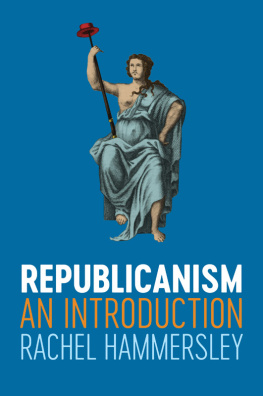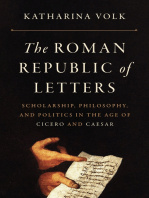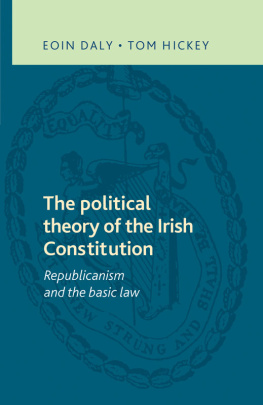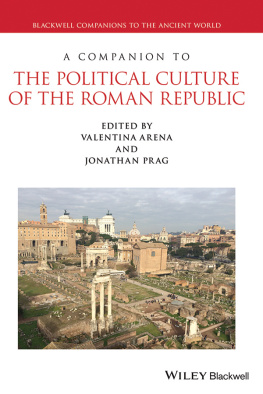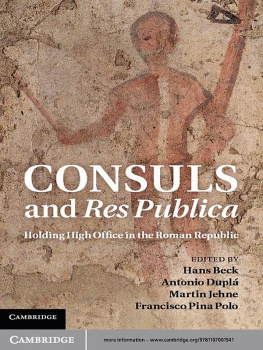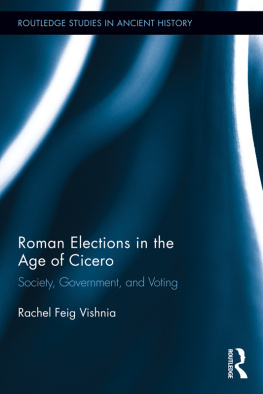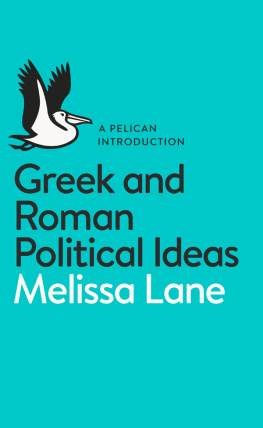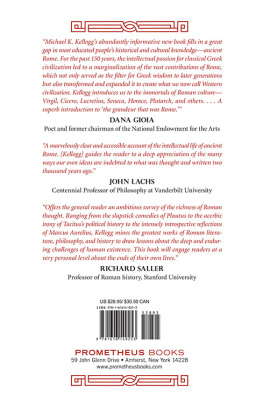
THE LIFE OF ROMAN REPUBLICANISM
THE LIFE OF ROMAN REPUBLICANISM
JOY CONNOLLY
PRINCETON UNIVERSITY PRESS
PRINCETON AND OXFORD
Copyright 2015 by Princeton University Press
Published by Princeton University Press
41 William Street, Princeton, New Jersey 08540
In the United Kingdom: Princeton University Press
6 Oxford Street, Woodstock, Oxfordshire OX20 1TW
press.princeton.edu
All Rights Reserved
Library of Congress Cataloging-in-Publication Data
Connolly, Joy, 1970
The life of Roman republicanism / Joy Connolly.
pages cm.
Includes bibliographical references and index.
ISBN 978-0-691-16259-1 (alkaline paper) 1. RomeHistoryRepublic, 51030 B.C. 2. RepublicanismRomeHistory. 3. Political scienceRomeHistory. 4. RomePolitics and government26530 B.C. I. Title.
DG231.C65 2015
937.02dc23 2014000095
British Library Cataloging-in-Publication Data is available
This book has been composed in Sabon Next LT Pro, Futura ND and Trajan Pro
Printed on acid-free paper.
Printed in the United States of America
1 3 5 7 9 10 8 6 4 2
TO MY PARENTS, WITH GRATITUDE AND LOVE
CONTENTS
PREFACE
IX
ACKNOWLEDGMENTS
XVII
INTRODUCTION
1
Where Politics Begins: Ciceros Republic
23
Justice in the World: The Execution of Jugurtha
65
Non-Sovereign Freedom in Horaces Satires
115
Dividual Advocacy
155
Imagination, Finitude, Responsibility, Irony: Ciceros pro Marcello
173
CONCLUSION
The Republic Remastered
203
BIBLIOGRAPHY
209
INDEX
219
PREFACE
Democracy risks being reduced to the mere exercise of delegation; we need tools and methodologies to face the challenges of the collective construction of knowledge by citizens, granting them the role they demand of arbiter of life in our cities.... This new paradigm entails new values, and it is precisely in the context of culture that we have to understand our work as a motor of new ways of rethinking and making [politics].... The objective of the book you are holding is to become a users manual for creative practices.
B Y YOUR PERMISSION I lay before you, in a series of letters, the results of my researches.... So Schiller opens his 1794 collection of letters on the aesthetic education of man (ber die sthetische Erziehung des Menschen in einer Reihe von Briefen). He explains that his main inspiration was Kant. I have no single philosophical guide or single hermeneutic model to point to, and because I have written this book in the hope of reaching across disciplines that are each armed with distinctive expectations of what makes a worthwhile book, I want to offer a short account of the conditions of its design here, before I explain its method and approach in the more formal Introduction. As I begin to sketch the troubles and disaffections that have driven my thinking, I recognize that many othersnotably political scientists, sociologists, and other social scientistshave tackled them at far greater length, with greater exactness, and using different tools. The volume of work on these problems is far too large to cite. So by your permission, to quote Schiller one more time, I set the scene, trusting from the evidencefound in everyday encounters with friends, family, colleagues, the newspaper, and the never-ending onslaught of violent movies and television shows portraying crime, corruption, and the apocalyptic destruction of the earththat the worries I describe here are not mine alone. They are pretty widespread. But reading is widespread too; and if I do not have a single hermeneutic model, I write with the conviction that reading carefully, giving close attention to how artful language works, offers one powerful if not completely reliable way to break through the crust of conventionalized and routine consciousness, as John Dewey put itin other words, to think ourselves out of this mess.
DEMOCRACY AS WE KNOW IT
On 24 September 2011, New York City police officer Anthony Bologna pepper-sprayed two Occupy Wall Street protesters who had been herded behind flexible orange mesh barriers a few minutes earlier. Several cameras caught the young women frantically swiping their tear-streaked faces, screaming in shock and pain, as the officer strode away ( Marchers on the road made it halfway down the bridgeonly to find themselves trapped by the NYPDs walls of orange mesh. Seven hundred people were rounded up and taken to precinct stations around the city that day, their arms leashed by prepared zip-ties the officers had at the ready.
Variations on this scene occurred across the country through the autumn of 2011, including on university campuses like UC Berkeley and Santa Monica. It has become a national and a global pattern, one driven by many intertwined factors. This suggests that public order is now valued more highly than the public expression of dissent, which tends to be framed as disorderly and thus dangerous by journalists, politicians, and the police. Spaces once viewed in the first instance as gathering places for free political debate, regardless of their formal legal identity as public or private, have been reinvented as spaces for commerce and consumption. (This is itself not an essentially depoliticizing move, since markets are political spaces, as the farmers at my local market on Union Square would strenuously insistbut I am thinking of the frequency with which groups applying for permission to march or meet for political reasons are delayed, moved, or denied access on the grounds that major open public spaces must be in the first instance kept safe for commerce.) Access to the airwaves is distributed on a pay-to-play basis. The university is being transformed into a virtual entity where relevance and concrete preparation for work have become primary criteria for the student-consumers choice of coursework, with minimal counter-advice coming from administrations eager for a reliable cash flow. Airports and government buildings operate as though they are the private property of the so-called security industry, whose employees enforce docility among the populace in the name of public safety and efficiency. Craig Calhoun notes that these developments encourage the right-wing view that private property is natural while public space (and perhaps the public interest) is optional.

FIGURE 1 Photo of Occupy Wall Street protesters after being pepper-sprayed. Photo credit: Jefferson Siegel / New York Daily News.
Why do so many citizens tolerate the police when they recklessly harm the harmless, why do they tolerate the entrenched corporate and political forces squeezing public space? Why are leaders and public opinion-makers so quick to brush off expressions of dissent as symptoms of disorder? Common senseas the Catalonian artists and activists who wrote my epigraph would surely argueascribes the tolerance of state interference and the decay of dissent on the one hand to the fear of change among the complacent well-off and the adherents of established political parties, and on the other to the alienation of the citizen majority from politics.
The novelist Jos Saramago sees citizen alienation as a rational if dismal response to the impossibility of seeing democracies in the developed world Other thinkers, following Jean-Jacques Rousseau and Hannah Arendt, suggest that the fundamental problem is not citizen apathy as measured by low participation in elections, but the fact that many citizens of democracies identify their role in politics primarily with voting. (It is telling that the electoral races with the highest degree of participation involve federal offices furthest from the citizenrys local life; in the United States, even these elections draw less than half of eligible voters.) When the act popularly perceived as central to democratic citizenship is the silent and unaccountable act of vesting power in others, something is wrong.
Next page

